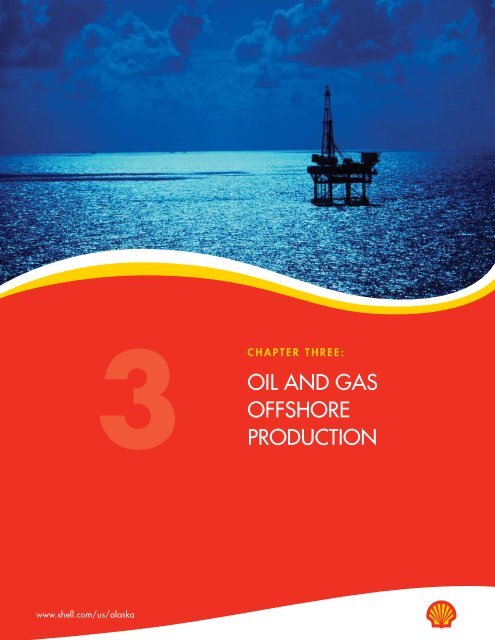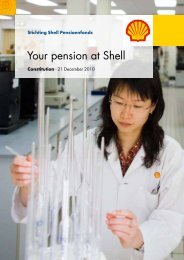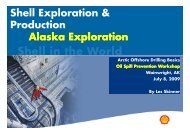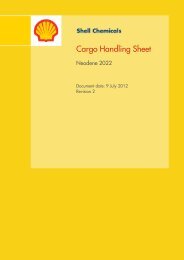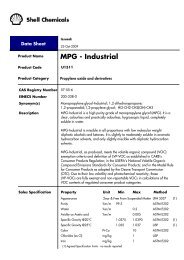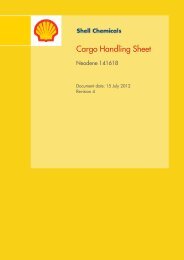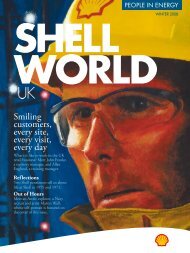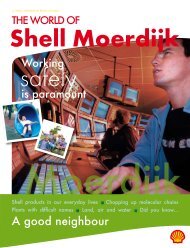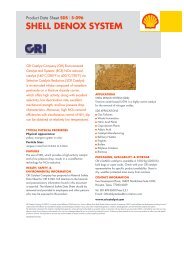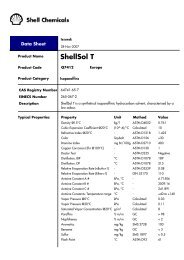Create successful ePaper yourself
Turn your PDF publications into a flip-book with our unique Google optimized e-Paper software.
3C H A P T E R T h r e e :Oil and GasOffshoreProductionwww.shell.com/us/alaska
PlanningPiltun-Astokhskoye Ba fixed production platform 7.5 miles offSakhalin Island in 105’ waters (2007).When exploration uncovers oil and gas fields with prospects for a good economic return, the nextstep is figuring out the best way to extract it. That planning period can take longer than even theexploration process. The time between the gathering of the first seismic data and the first barrel of oilis typically at least eight years — and can be as many as 20.Some of the first things to consider are what types of platforms, pipelines and vessels are best suitedto the region. Decisions must be made about how the petroleum* should be transported to onshorefacilities. Questions about how and where the oil and gas will be processed and transported to marketmust also be resolved before any construction can begin on the production phase of the project.Host FacilitiesIn offshore production, oil and gas are extractedfrom the wells and brought to the surface to a hostfacility above the ocean surface. The type of facilitydepends on the location, water depth, climate andthe facility’s size and capabilities. Environmental,safety, stakeholder and financial issues are alsoconsidered when selecting among the options.Resisting Environmental ForcesHurricanesPlatforms in tropical, hurricane-prone regions andareas subject to extreme storms such as the North Seaoff the coast of the United Kingdom are specificallydesigned to resist extreme waves and winds and tominimize environmental damage. In the Gulf ofMexico, hurricanes can produce winds of 150 mphor more and massive waves over 75 feet high, andplatforms there must be able to withstand thoseforces over an average 30-year production life.Close monitoring of the weather allows platformcrews to prepare for evacuation by halting drillingactivities, securing the facility and shutting downproduction. The platforms are structurally reinforcedfor added resistance and equipped with devices suchas surface controlled subsea safety valves to sealoff the wells thousands of feet down. Hurricaneresistantplatforms are designed to survive direct hitsfrom these storms without significant damage.EarthquakesPlatforms in seismic zones, like Alaska’sCook Inlet, California and Russia’s SakhalinIsland, are built to resist the intense groundmovements caused by earthquakes. Structuresin these areas are designed to have the strengthto ensure no damage from earthquakes.CurrentsThe changing motions of tides and currents cancause severe structural stress to platforms. Tidalswings of 30 feet occur in the Cook Inlet twicedaily, pushing winter ice against the platform withevery cycle. Here, the platforms must be speciallystrengthened to resist ice impact and protect the wells.Bottom Supported PlatformsGravel IslandsMan-made gravel islands may be used year-round inwater depths of up to 50 feet and can support largedrilling rigs and oil and gas production equipment.Many tons of gravel are placed on the seafloor tocreate the island. When production is completed,the islands may be left to erode naturally or dredgedto a depth that allows for vessel navigation. Gravelislands typically must be strengthened with concrete,rock or steel sheet piles to resist the impact of ice.Steel JacketTypical fixed steel platforms consist of large pipe legsand a tubular steel cross bracing that form a “jacket.”The jacket is supported by piles driven into the seafloorto transmit wave, wind, current or ice forces into theground. They support a deck that contains a drillingrig, the crew’s living quarters and production facilities.Jackets are usually used in shallow to medium waterdepths and are intended for long-term use. Steeljacket platforms can operate in up to 1,400 feet ofwater and withstand hurricanes and winter storms.They are typically not the best solution for severearctic areas with large ice ridges and multi-year ice.* The terms “petroleum,” “hydrocarbons” and “oil and gas” are often used interchangeably throughout this text. For definitions and distinctions, refer to the glossary at the end of this chapter.2 <strong>OIL</strong> <strong>AND</strong> <strong>GAS</strong> <strong>OFFSHORE</strong> <strong>PRODUCTION</strong> <strong>OIL</strong> <strong>AND</strong> <strong>GAS</strong> <strong>OFFSHORE</strong> <strong>PRODUCTION</strong> 3
Production PlatformsGravity-Based StructuresThese platforms take advantage of their largesize and heavy mass to support large facilities inwater depths of up to 1,000 feet. They can also bedesigned to resist severe arctic conditions, such asmulti-year ice and even icebergs in shallow watersand in depths of up to around 200 feet. Gravitybasedstructures (GBSs) can be made of steel orconcrete, and provide support for heavy drillingrigs and production equipment. They functionsimilarly to gravel islands and jacket structures, butcan be used in deeper water than gravel islands andcan resist ice much better than jacket structures.They effectively act as steel or concrete islands.Compliant TowersIn deeper waters (over 1,000 feet), small steadywaves can start to cause fatigue on fixed platformstructures. The constant action of millions of wavecycles against the platform is similar to bending apaper clip back and forth until, over time, it breaks.“Compliant Tower” platforms may be used insteadfor operating in depths of 1,000 to 3,000 feet.The platforms are slender and so flexible that theysway when hit with these small waves so they don’texperience the fatigue that a fixed platform wouldsee in these great depths. The narrow, flexible towershave pile foundations and can support a conventionaldeck for drilling and production operations.Floating RigsTension Leg Platforms (TLPs)These floating platforms can support a drillingrig and production facilities. The TLPs are similarto fixed platforms except they use a floating hulltethered to the seafloor by a mooring system madeof tension legs. These steel “tendons” limit verticalmovements from wind and sea forces and keepthe TLP in position. Many TLPs are built with afour-column design that supports the deck section.Below the water, a ring of pontoons connects thecolumns, much like a semi-submersible drilling vessel.TLPs can be used in up to 6,000 feet of water.Semi-SubmersiblesA semi-submersible production platform consists ofa deck supported by four columns and connectedunderwater by four pontoons. Similar to TLPs,semi-submersibles can support living quarters andproduction equipment. Unlike TLPs, their floatinghull uses a conventional lateral mooring system ofsteel cables to keep the platform in position andare connected to subsea wells via flowlines. Thesubsea wells are drilled by mobile offshore drillingunits (see page 7) since there is typically not a drillrig on a semi-submersible production platform.SparsMuch like the TLP, Spars are moored to theseafloor, but with a more conventional lateralmooring anchoring system instead of tensionlegs. They are supported by a floating, hollowcylinder containing extra weight in the bottom,similar to a huge buoy. About 90 percent of thestructure is underwater, so it has great stability invery deep waters — as much as 10,000 feet.FPSOsFloating production storage and offloading units(FPSOs) can operate in water depths up to 10,0004 <strong>OIL</strong> <strong>AND</strong> <strong>GAS</strong> <strong>OFFSHORE</strong> <strong>PRODUCTION</strong><strong>OIL</strong> <strong>AND</strong> <strong>GAS</strong> <strong>OFFSHORE</strong> <strong>PRODUCTION</strong>5
Designing a structure to resist arctic ice requiresa thorough understanding of ice forces that isgained through a combination of actual ice forcemeasurements, ice model tests and engineeringanalyses. The configuration of an appropriateplatform will depend on the severity of the ice atthe location. In mild ice, the platform may havemultiple columns. In severe ice, the platform may becomposed of a single, large column. In all cases, thewells must be protected from the ice by containingthem within the structure. Special arctic materials mustbe used to make sure that the structure can maintainits strength in the extreme cold. Foundations must bebroad, contain extra “ballast” weight for stability andcut into the seafloor to resist ice loading.Platforms andGravity-Based Structures (GBS)The first Cook Inlet platforms in Alaska, installed byShell, placed the wells in large diameter legs thatprevented the tides from pushing sea ice into theProduction Systems in the Arcticwells. Platforms in Russia’s Sakhalin Island use largediameter concrete legs to provide similar protection.Gravel IslandsGravel islands are another option for arctic regionsin shallower waters (up to about 50 feet). They areconstructed with gradually sloping beaches andprotective materials to resist ice.Subsea WellsSubsea production systems typically lie directly onthe seafloor. In the shallower waters of the Arctic,however, ice keels or icebergs pose the potentialrisk of colliding with the equipment. In these areas,the subsea equipment may be placed in a holedredged into the seafloor so that the ice will passover it without causing any damage. In deeper waterdepths, pipeline and subsea equipment may be safelyplaced directly on the seafloor, below the potentialthreat of ice keels.feet and are best suited for milder climates or wherethere is limited pipeline systems to transport oilto shore. These ship-like vessels can process all ofthe oil or gas produced from a reservoir, separatingthe oil and gas and storing the oil until it can beoffloaded to tankers for transportation. The storagecapacity of the FPSO allows oil to be stored andthen periodically offloaded to a tanker so that thetanker does not need to be on standby for longperiods while waiting to receive production. Theseparated gas may be reinjected into a reservoir in theground or exported to shore through a gas pipeline.Subsea wells send production to the FPSO throughlines called “risers,” which are flexible enough toresist the heaving motion of the vessel above.Designs vary to allow different capabilities; somemay be able to store and offload (an FSO forexample) but do not process hydrocarbons. Mostvessels use mooring systems connected to a “turret.”The turret is mounted to the hull and allows thevessel to rotate freely. Called “weathervaning,”this action allows the vessel’s bow always to pointinto the winds and currents, minimizing theimpact of those forces. FPSOs are either modifiedexisting tankers or can be newly constructed.Mobile Offshore Drilling UnitsWells are drilled from mobile offshore drilling units(MODUs) when no platform exists. MODUs areused for exploration wells and subsea productionwells. They support the drilling equipment and livingquarters, but have no processing equipment and can beeasily moved once the drilling is done. MODUs allowthe drilling of additional subsea wells into reservoirsthat may be many miles away from existing platforms.Subsea Production SystemsSubsea production systems are composed of wells,manifolds and flowlines lying directly on the seafloor.Wells for semi-submersible platforms and FPSOsare subsea wells drilled from MODUs. Additionally,subsea wells can be connected to other systems,like Spars, FPSOs or platforms to extend the reachto nearby reservoirs, allowing existing platformsto maintain productions rates and reducing theneed for additional platforms. The oil and gasfrom subsea wells flow in flowlines to processingplatforms that may be from five to 100 miles away.DrillingProduction WellsThe earliest knownoil wells weredrilled in China inthe fourth centuryand had depths ofabout 800 feet. Today,offshore well depthsrange between one half andfive miles. At such depths, the Earth’s temperaturesand pressures are tremendous. The pressure canbe 1,000 times greater than at the surface and thetemperature can reach 400 degrees F. Well designsmust consider these severe conditions at the bottomof the well as well as temperatures at the surface,which can be -60 degrees F in arctic areas.Wells are inspected and maintained to ensure safeoperations throughout production, which can lastas long as 50 years. As oil or gas are produced fromthe reservoir, it may become necessary to modify thewell or drill new ones to maintain production levels.Production information gathered from the variouswells, and sometimes new seismic data, will allow abetter understanding of the reservoir and potentiallyidentify additional reserves that can be produced.DrillingIn conventional drilling, the hole-boring drill bitis pressed against the ground and rotated. Heavierdrill pipe and “drill collars” are added to provideweight on top of the bit and this enables the teethof the bit to gouge the rock and grind it into smallpieces, or cuttings. Just as with digging a hole,those rock cuttings must be brought up out ofthe way to allow the drill to go deeper. To achievethis, a drilling fluid called “mud” is fed down the6 <strong>OIL</strong> <strong>AND</strong> <strong>GAS</strong> <strong>OFFSHORE</strong> <strong>PRODUCTION</strong><strong>OIL</strong> <strong>AND</strong> <strong>GAS</strong> <strong>OFFSHORE</strong> <strong>PRODUCTION</strong>7
Directional Drillingthe future, may be drilled from this central location,potentially extending the platform’s productive life.Directional drilling can also be used in places whereit is not possible to position the rig directly over thereservoir. It is now possible to start drilling on onepiece of land and cross under a body of water or evena city to another piece of land to reach the reservoir.One well on England’s southern coast was drilledhorizontally underneath a village all the way to anoffshore field to preserve the area’s natural beauty.A motor on the rig called a “top drive” or a “rotarytable” is usually used to rotate the drill pipe anddrill bit. In directional drilling, the bit initially digsstraight down and then it is turned a few degrees ata time to follow a designated path. In some cases,instead of rotating the pipe from the surface, a“downhole mud motor” is attached to the bottom ofthe pipe and the bit alone is rotated by the force ofthe circulating mud. Directional drilling techniquesare so accurate that targets of less than a few feet widecan be hit, even from distances of several miles.hole from caving in, and acts as a foundation orsupport for the rest of the well. Extra sections ofdrill pipe are attached to lengthen the “drill string”to allow the well to be drilled deeper. At certainintervals, due to changes in rock strength or pressure,the well must be protected by additional metal pipescalled “casing” that line the inside of the well andare sealed in with cement. Conventional drillingstarts with a large diameter hole at the Earth’s surfacethat gradually gets smaller as each metal tube mustpass through the previous one. This typically lookslike an extended telescope or car antenna, only ona larger scale. Today we are developing expandabletubes or casings that are narrow enough to passthrough the initial casing but can then expand tomatch the diameter of the first, wider casing. Theability to maintain the same diameter hole from topto bottom means we can tap reserves conventionalmeans cannot reach. The technology also allows us todrill narrower wells, but recover the same amount ofhydrocarbons that would normally require larger wells.Well CompletionOnce the hole is drilled into the reservoir and thefinal string of casing is cemented in place, tubing isinserted in the casing to bring the oil and gas to thesurface. The tubing serves several purposes; it protectsthe casing from corrosion and is easier to replacethan the casing if it does get damaged. The tubingcan be equipped with devices to control and monitorthe hydrocarbon flow and to stop flow completelyin emergency situations. The special valves andfittings that control hydrocarbon flow and measurethings like pressure and volume, called a “ChristmasTree,” may either be placed above the surface of thewater or on the seafloor at the top of the well.drill pipe and into the bit, where it sprays throughjets pushing the cuttings away. The mud andcuttings are forced up to the surface through aspace between the outside of the drill pipe and theinside of the hole. The mud is usually a mixtureof clays, additives and water that is very carefullyblended to ensure the best possible performancein the existing conditions. The mud, which is alsoused to cool the equipment, is then filtered to cleanout the rock cuttings and circulated back throughthe pumps and into the drill pipe once more.Directional DrillingIn the past, oil wells were drilled straight downinto the Earth. One of the greatest oil-industryadvances is the ability to drill horizontally. This“directional drilling” allows the operator to reachmany reservoirs from one drilling rig, maximizingthe amount of oil or gas that can be produced fromone location. A platform will occupy only a smallportion of the whole oil field, which can stretchover many square miles. Directional drilling allowswells to extend out from a central platform intomultiple reservoir locations like a system of treeroots. This allows the installation of fewer platformsand means that additional reservoirs, identified inDerrick and HoistingManaging all this heavywork from above isa block-and-tacklesystem hangingfrom a tall masterected on theplatform. That“derrick” is the mostrecognizable structurein the industry andcan tower more than200 feet in the air. The hoisting system controlsthe weight of the drill pipe on the bit, andraises the drill pipe in and out of the hole.CasingWhen a well is started, or “spudded,” sometimes aguide base of metal pipe or “conductor” is set intothe seabed. This positions the drill bit, prevents theDrilling SafelyA key safety mechanism called a “blowout preventer”is installed on the top of the casing, or “wellhead,”while drilling. Under normal drilling conditions,hydrocarbons are prevented from flowing out of thereservoir by the weight of the drilling mud, whichcounterbalances the reservoir pressure. If for some8 <strong>OIL</strong> <strong>AND</strong> <strong>GAS</strong> <strong>OFFSHORE</strong> <strong>PRODUCTION</strong> <strong>OIL</strong> <strong>AND</strong> <strong>GAS</strong> <strong>OFFSHORE</strong> <strong>PRODUCTION</strong> 9
Well CasingSubsurface safety valveUp to 150 feetSubsurface safety valves are located in all well bores approximately 300 feetbelow the seafloor that will automatically close to isolate the reservoir andprevent the oil and gas from escaping into the environment.reason this balance is lost, the blowout preventerensures the safe containment and flow of anypressurized fluids that might otherwise erupt and causean uncontrolled release of hydrocarbons. Gone are thedays of those “gushers” — the fountains of oil thatonce shot into the skies from the wooden derricks ofyesteryear when blowout preventers were not availableor commonly used.Petroleum Varieties and ProductsCrude oil is a liquid that comes from reservoirsbelow the Earth’s surface. The term “crude” is usedbecause the liquid has yet to be processed or refinedinto consumer products. The refining processeventually yields products such as gasoline, jet fuel,heating oil, butane, propane, diesel and asphalt.Crude oil is composed of molecules containingcarbon and hydrogen atoms. Natural gas, water,sediment and other impurities are usually mixedwith the oil and gas as it comes out of the groundand must be removed prior to transporting it tomarket. Crude oil runs the gamut from heavymolasses-type mixtures to fluids similar to cookingoils. How easily an oil flows has a direct impact onthe design of the gathering and processing system.ProductionExtractionThe oil, water and gas sometimes travel from thereservoir to the surface under their own pressure(natural drive). If reservoir pressures are low,however, artificial lift is employed. Artificial lift canbe in the form of in-well or seafloor pumps and issometimes accompanied with in-well heating and/orgas lift systems. Some reservoirs contain heavy oilsthat require artificial lift. The cold temperatures indeepwater or in the Arctic also play a role in howwell the oil flows. Sometimes water or produced gasis injected into the reservoir to maintain pressureand force oil toward the production wells.ProcessingOnce at the surface, production from the well is sent toa separator to be divided into its base components —oil, gas and water. The oil is dehydrated in a bulk oiltreater before being sent to storage. It is then exportedvia a crude oil pipeline or a shuttle tanker to a refinery.The gas is also dehydrated before it is compressed andexported by pipeline. In some cases, injection wells aredrilled to store gas safely in a reservoir for potentialproduction in the future. The produced water iscleaned to required levels and then, depending onthe location, may be discharged overboard, pumpedinto a disposal well or injected into the reservoiras a pressurizing system for further oil recovery.10 <strong>OIL</strong> <strong>AND</strong> <strong>GAS</strong> <strong>OFFSHORE</strong> <strong>PRODUCTION</strong> <strong>OIL</strong> <strong>AND</strong> <strong>GAS</strong> <strong>OFFSHORE</strong> <strong>PRODUCTION</strong> 11
Production Drilling BasicsSafe Operations — Living andWorking OffshoreThe crew size on an offshore platform can rangefrom 10-15 for small, near-shore facilities, to as manyas 150-200 members for larger operations. The livingquarters include a cafeteria-type kitchen, recreationand exercise rooms, medical facilities, laundry rooms,maintenance shops, warehouses and laboratories. Theoperations are continuous and require coverage by dayand night crews, who live on the platform during theirentire time offshore. Typically one crew works on theplatform for a 14-day stretch, while another enjoystheir 14 days off at their homes, many pursuing sidejobs or hobbies.Extensive fire and safety systems are installedthroughout the platform, including equipment thatautomatically shuts down oil and gas productionin the event of an emergency. Every crewmemberon the platform is authorized to shut down theplatform should they detect an unsafe condition. Theshut down system is required to halt all productionwithin 45 seconds. Valves are used to isolate thevarious systems and minimize environmentalimpact should any system problem be identified.Subsurface safety valves are located in all well boresapproximately 300 feet below the seafloor that willautomatically close to isolate the reservoir and preventthe oil and gas from escaping into the environment.Should evacuation be necessary, the crew has anumber of options ranging from helicopters, boats,survival capsules and life rafts. In arctic regions,specialized vehicles that can travel across ice orwater are provided to carry the crew to safety.12 <strong>OIL</strong> <strong>AND</strong> <strong>GAS</strong> <strong>PRODUCTION</strong> <strong>OIL</strong> <strong>AND</strong> <strong>GAS</strong> <strong>OFFSHORE</strong> <strong>PRODUCTION</strong> 13
GlossaryCasing – steel pipe placed in an oil or gas well to prevent thewall of the hole from caving in, to prevent movement of fluidsfrom one formation to another and to aid in well control.Christmas Tree – the control valves, pressure gauges, andchokes assembled at the top of a well to control flow of oiland/or gas after the well has been drilled and completed.Derrick – a tapered mast of open steel framework used indrilling to support the drill string and other equipment.Directional Drilling – the deviation of a well hole from avertical drilling angle. The method allows the operator to reachmany reservoirs from one drilling rig, maximizing the amountof oil or gas that can be produced from one location.Gravel Island – a man-made construction of gravel used as a platformto support drilling rigs and oil and gas production equipment.Hydrocarbons – organic chemical compounds of hydrogen and carbonatoms forming the basis of all petroleum products. They may exist as gases,liquids or solids. An example of each is methane, hexane and asphalt. Forthis document the terms “hydrocarbons,” “petroleum” and “oil and gas” areinterchangeable.MODU – Mobile Offshore Drilling Unit often used in conjunction withsemi-submersibles and FPSOs, which do not have drilling rigs.Petroleum – a substance occurring naturally in the earth in solid, liquid, orgaseous state and composed mainly of mixtures of chemical compounds ofcarbon and hydrogen, with or without other nonmetallic elements such assulfur, oxygen and nitrogen. In some cases, especially in the measurementof oil and gas, petroleum refers only to oil — a liquid hydrocarbon — anddoes not include natural gas or gas liquids such as propane and butane.For this document the terms “hydrocarbons,” “petroleum” and “oil and gas”are interchangeable.Platform – the structure that supports production and drilling operations.The types of offshore platforms can be either floating or fixed, dependingon the location, water depth, climate and the facility’s size.Rig – the drilling equipment used to drill the well that caneither be installed on a platform or a MODU.Spud – to begin operations on a well.Well Completion – the process of preparing a well for the productionof oil and gas in which one or more flow paths for hydrocarbonsare established between the reservoir and the surface.Sources• American Petroleum Institute• Baker, Ron, A Primer of Offshore Operations, University of Texas atAustin, 1998• Encyclopedia Britannica• General Maritime Corporation• Oil and Gas UK• Natural Gas Supply Association• Sakhalin Energy Drilling Supervisors• Schlumberger Oilfield Services• Society of Petroleum Engineers• State of Alaska Dept. of Natural Resources Division of Oil and Gas• The Learning Space (http://openlearn.open.ac.uk)• The National Ocean Industries Association• United States Maritime Administration• U.S. Minerals Management Service,Department of the Interior<strong>OIL</strong> <strong>AND</strong> <strong>GAS</strong> <strong>OFFSHORE</strong> <strong>PRODUCTION</strong> 15
Shell in AlaskaTo find and develop commercialhydrocarbon resources in the Chukchiand Beaufort Outer Continental Shelf.To support communities where weoperate in benefiting from any potentialoffshore activities economicallyand socially. To respect the way oflife of the residents of Alaska.


